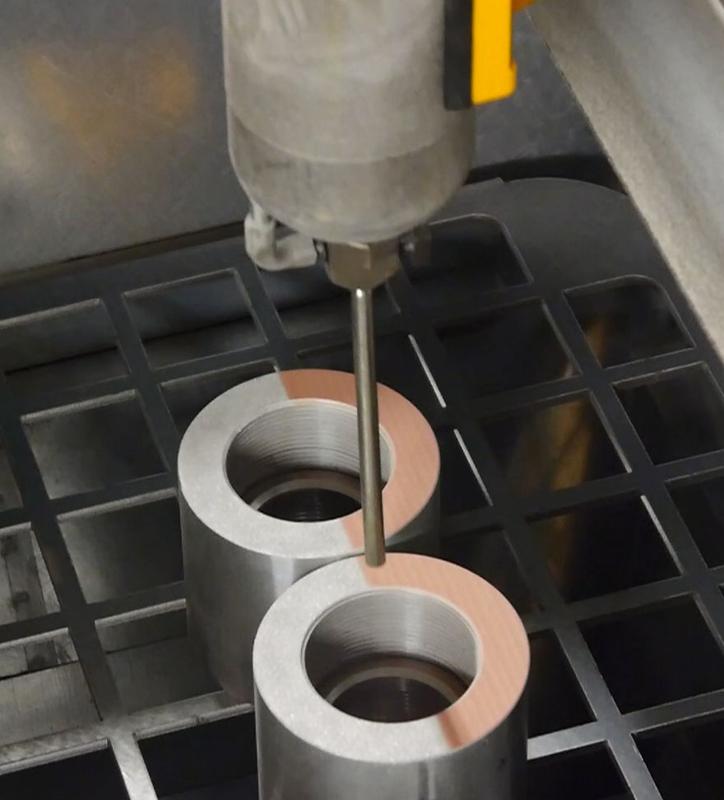Short Laser Pulses for Material Deposition with Cold Spray Technology

High-speed deposition of copper on aluminum segments. Picture source: Dycomet
Cold Gas Spraying is an additive manufacturing process in which metal powders are accelerated to supersonic speeds to adhere to material surfaces. The material deposition process is based on the kinetic energy of the particles.
A thick layer (>0.5 mm) is deposited with no thermal defect in the substrate. The deposited layer can be directly machined or reworked. The main advantages of low-pressure cold gas spraying are the lack of heat input, high processing speed, and low investment cost. New material combinations are especially promising in automotive and aeronautics.
The main challenge in this technology is the adherence of the first layer on the workpiece. The aim of the EU research project “Efficient Manufacturing of Laser-Assisted Cold-Sprayed Components” (EMLACS) will improve adhesion on different substrates by using high-speed laser surface structuring with integrated ns and ps lasers with low-pressure cold gas spraying. New material combinations can then be developed for industrial use.
The deposition of metallic materials (Cu or Al) on carbon fiber and glass fiber reinforced plastic (CFRP and GFRP) substrates is being investigated, which has already created significant interest in the aeronautic and automotive industries. In addition, the new technology can be applied in novel ways in electronics manufacturing. As an example, Cold Gas Spraying may deposit a copper layer on a non-conducting housing for fanless heat removal from electronic components.
The project team is composed of French, Dutch, and German partners. Dycomet Europe (NL) brings cold gas spraying expertise, Edgewave (GER) delivers high-power short-pulsed laser technology, and Industrial Laser Systems (FR) is acting as the system integrator and coordinator of the project. Research teams from Université de Technologie de Belfort-Montbéliard (UTBM, FR) Fraunhofer-Institute for Laser Technology ILT (GER) are developing the process.
The EMLACS project (reference number 606567) has been running since June 2014 under Research for SMEs – FP7-SME-2013 and has been funded by the Research Executive Agency (REA) for 24 months.
Contact
Manuel Mendes
Industrial Laser Systems
Telephone +33 1 55950950
mmendes@industrial-laser-systems.com
21-23 rue Aristide Briand, 92170 Vanves, France
www.industrial-laser-systems.com
Dr.-Ing. Wolfgang Knapp
Head of the Coopération Laser Franco-Allemande CLFA
Telephone +33 2 2844 3711
wolfgang.knapp@ilt.fraunhofer.de
Fraunhofer-Institute for Laser Technology ILT
Steinbachstraße 15
52074 Aachen, Germany
Media Contact
All latest news from the category: Machine Engineering
Machine engineering is one of Germany’s key industries. The importance of this segment has led to the creation of new university degree programs in fields such as production and logistics, process engineering, vehicle/automotive engineering, production engineering and aerospace engineering among others.
innovations-report offers informative reports and articles covering technologies such as automation, motion, power train, energy, conveyor, plastics, lightweight construction, logistics/warehousing, measurement systems, machine tools and control engineering.
Newest articles

Sea slugs inspire highly stretchable biomedical sensor
USC Viterbi School of Engineering researcher Hangbo Zhao presents findings on highly stretchable and customizable microneedles for application in fields including neuroscience, tissue engineering, and wearable bioelectronics. The revolution in…

Twisting and binding matter waves with photons in a cavity
Precisely measuring the energy states of individual atoms has been a historical challenge for physicists due to atomic recoil. When an atom interacts with a photon, the atom “recoils” in…

Nanotubes, nanoparticles, and antibodies detect tiny amounts of fentanyl
New sensor is six orders of magnitude more sensitive than the next best thing. A research team at Pitt led by Alexander Star, a chemistry professor in the Kenneth P. Dietrich…





















